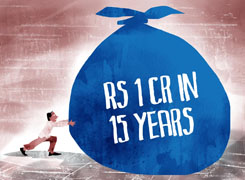Ramalingam Kalirajan |10874 Answers |Ask -Follow
Mutual Funds, Financial Planning Expert - Answered on Jun 25, 2024
He has an MBA in finance from the University of Madras and is a certified financial planner.
He is the director and chief financial planner at Holistic Investment, a Chennai-based firm that offers financial planning and wealth management advice.... more

28 yrs old, Investing ?10k pm in MFs (total ?44k), FD maturing soon (?40k), RD ongoing (?8k monthly, approx ?75k, goal 2L) and PPF at ?1.16 lakh (matures in 9 years). Target monthly expense post-retirement: ?1Lakh. Considering Digital Gold SIP too. I need to retire by 50 age or before. What more I need to do, please guide.
Current Financial Situation
Let’s summarize your current investments:
Mutual Funds: Rs 10,000 per month, totaling Rs 44,000 invested.
Fixed Deposit: Rs 40,000 maturing soon.
Recurring Deposit: Rs 8,000 per month, with a goal of Rs 2 lakh.
Public Provident Fund (PPF): Rs 1.16 lakh, maturing in 9 years.
Building a Strong Financial Foundation
A solid financial foundation is crucial for achieving your retirement goals:
Emergency Fund: Ensure you have an emergency fund covering 6-12 months of expenses. This provides a safety net during unexpected situations.
Insurance: Adequate health and life insurance are essential. This protects you and your family from unforeseen events.
Accelerating Your Debt Repayment
If you have any debt, prioritize repaying it:
High-Interest Debt: Focus on paying off high-interest debts first. This reduces your overall interest burden and improves your financial health.
Investing in Mutual Funds
Mutual funds are a great way to grow your wealth:
Diversification: Invest in a mix of equity and debt mutual funds. This balances risk and returns.
Systematic Investment Plans (SIPs): Continue your SIPs and gradually increase the amount as your income grows.
Regular Review: Review your mutual fund portfolio annually with a Certified Financial Planner (CFP) to ensure it aligns with your goals.
Fixed Deposits and Recurring Deposits
Fixed and recurring deposits offer stability:
Reinvestment: Once your FD matures, reinvest the amount in a diversified portfolio. This could include mutual funds or other investment options.
Goal Achievement: Use the RD to achieve your short-term goal of Rs 2 lakh. After reaching this goal, redirect the funds towards long-term investments.
Public Provident Fund (PPF)
PPF is a reliable long-term investment:
Consistent Contributions: Continue contributing to your PPF account. It offers tax benefits and guaranteed returns.
Maturity Planning: Plan for the maturity of your PPF in 9 years. Consider reinvesting the maturity amount for continued growth.
Considering Digital Gold SIP
Digital gold can be part of your investment portfolio:
Small Allocation: Allocate a small portion of your investment to digital gold. It acts as a hedge against inflation.
Regular Investment: Invest systematically through a Digital Gold SIP to benefit from rupee cost averaging.
Diversifying Your Investments
Diversification reduces risk and enhances returns:
Equity Funds: Increase your exposure to equity mutual funds for higher returns. This helps in long-term wealth creation.
Debt Funds: Include debt funds for stability and regular income. This balances your portfolio.
Gold: Continue with a small allocation to digital gold for diversification.
Planning for Inflation
Inflation reduces purchasing power over time:
Growth Investments: Invest in assets that grow faster than inflation, like equity mutual funds and stocks.
Regular Adjustments: Review and adjust your investments regularly to stay ahead of inflation.
Estimating Retirement Corpus
Estimate the total corpus needed to generate Rs 1 lakh monthly post-retirement:
Current Expenses: Calculate your current monthly expenses.
Future Expenses: Consider inflation to estimate future expenses.
Corpus Calculation: Determine the total corpus needed to generate the desired monthly income.
Systematic Withdrawal Plan (SWP)
An SWP helps in managing post-retirement income:
Regular Income: SWP allows you to withdraw a fixed amount from your mutual fund investments regularly.
Tax Efficiency: It is more tax-efficient compared to withdrawing a lump sum.
Investing in Actively Managed Funds
Actively managed funds can offer better returns:
Professional Management: Actively managed funds are managed by experienced fund managers.
Higher Returns: They have the potential to outperform the market and deliver higher returns compared to index funds.
Avoiding Direct Funds
Direct funds might seem cost-effective but come with disadvantages:
Lack of Guidance: Investing directly means missing out on professional advice.
Complexity: Managing direct funds requires a deep understanding of the market and regular monitoring.
Benefits of Regular Funds through CFP
Investing through a CFP ensures expert guidance:
Customized Plan: A CFP provides a personalized investment plan based on your goals and risk tolerance.
Regular Reviews: They conduct regular reviews and adjustments to your portfolio, ensuring it remains aligned with your objectives.
Creating a Financial Roadmap
A clear roadmap helps you stay on track:
Short-Term Goals: Identify and achieve short-term financial goals like building an emergency fund and clearing debt.
Long-Term Goals: Focus on long-term goals like retirement planning and wealth creation.
Increasing Your Investment Amount
Gradually increase your investment amount as your income grows:
SIP Increase: Increase your SIP amount periodically to accelerate wealth creation.
Bonus or Increment: Invest any bonuses or salary increments for better returns.
Professional Guidance
Seek professional guidance from a Certified Financial Planner:
Expert Advice: A CFP provides expert advice and personalized investment strategies.
Regular Monitoring: They monitor your investments regularly and suggest necessary adjustments.
Monitoring and Reviewing Investments
Regular monitoring and reviewing are crucial for success:
Annual Review: Conduct an annual review of your investment portfolio.
Adjustments: Make necessary adjustments based on performance and changing financial goals.
Future-Proofing Your Investments
Future-proof your investments to ensure long-term financial security:
Diversified Portfolio: Maintain a diversified portfolio to manage risk.
Professional Guidance: Seek regular advice from a Certified Financial Planner.
Flexibility: Be flexible with your investment strategy to adapt to changing market conditions.
Final Insights
Retiring by 50 with a monthly expense of Rs 1 lakh is achievable with disciplined planning and smart investments. Continue your SIPs, reinvest maturing FDs, and contribute to your PPF. Diversify your investments with equity, debt, and digital gold. Seek professional guidance, regularly review your portfolio, and make necessary adjustments. Stay disciplined and focused on your goals. Best of luck on your financial journey!
Best Regards,
K. Ramalingam, MBA, CFP,
Chief Financial Planner,
www.holisticinvestment.in
You may like to see similar questions and answers below
Ramalingam Kalirajan |10874 Answers |Ask -Follow
Mutual Funds, Financial Planning Expert - Answered on Apr 30, 2024
Ramalingam Kalirajan |10874 Answers |Ask -Follow
Mutual Funds, Financial Planning Expert - Answered on Apr 29, 2024
Ramalingam Kalirajan |10874 Answers |Ask -Follow
Mutual Funds, Financial Planning Expert - Answered on May 11, 2024
Ramalingam Kalirajan |10874 Answers |Ask -Follow
Mutual Funds, Financial Planning Expert - Answered on Jul 30, 2025
Naveenn Kummar |233 Answers |Ask -Follow
Financial Planner, MF, Insurance Expert - Answered on Sep 17, 2025
Mayank Chandel |2567 Answers |Ask -Follow
IIT-JEE, NEET-UG, SAT, CLAT, CA, CS Exam Expert - Answered on Dec 08, 2025
Mayank Chandel |2567 Answers |Ask -Follow
IIT-JEE, NEET-UG, SAT, CLAT, CA, CS Exam Expert - Answered on Dec 08, 2025
Mayank Chandel |2567 Answers |Ask -Follow
IIT-JEE, NEET-UG, SAT, CLAT, CA, CS Exam Expert - Answered on Dec 08, 2025
Mayank Chandel |2567 Answers |Ask -Follow
IIT-JEE, NEET-UG, SAT, CLAT, CA, CS Exam Expert - Answered on Dec 08, 2025
Anu Krishna |1746 Answers |Ask -Follow
Relationships Expert, Mind Coach - Answered on Dec 08, 2025
Ramalingam Kalirajan |10874 Answers |Ask -Follow
Mutual Funds, Financial Planning Expert - Answered on Dec 08, 2025
Samraat Jadhav |2499 Answers |Ask -Follow
Stock Market Expert - Answered on Dec 08, 2025
Ramalingam Kalirajan |10874 Answers |Ask -Follow
Mutual Funds, Financial Planning Expert - Answered on Dec 08, 2025
Radheshyam Zanwar |6737 Answers |Ask -Follow
MHT-CET, IIT-JEE, NEET-UG Expert - Answered on Dec 08, 2025
Nayagam P P |10852 Answers |Ask -Follow
Career Counsellor - Answered on Dec 07, 2025

Research Career Prospects: IISc, IITs, and Beyond: For research-oriented careers, the Integrated M.Sc Physics program at Amrita provides an exceptional foundation. Amrita's curriculum specifically aligns with GATE and UGC-NET examination syllabi, and the institution emphasizes early research engagement. The faculty at Amrita actively publish research in Scopus-indexed journals, with over 60 publications in international venues within the past five years, exposing you to active research environments.
To pursue research at premier institutions like IISc, you would typically follow the PhD pathway. IISc accepts M.Sc graduates through their Integrated PhD programs, and with your Amrita M.Sc, you're eligible to apply. You'll need to qualify the relevant entrance examinations, and your integrated program's emphasis on research fundamentals provides strong preparation. The final year of your Integrated M.Sc is intentionally structured to be nearly free of classroom commitments, enabling engagement with research projects at institutes like IISc, IITs, and National Labs. According to Amrita's data, over 80% of M.Sc Physics students secured internship offers from reputed institutions during academic year 2019-20, directly facilitating research career transitions.
Placement and Direct Employment Opportunities: Amrita University boasts a comprehensive placement ecosystem with strong corporate and government sector connections. According to NIRF placement data for the Amrita Integrated M.Sc program (5-year), the median salary in 2023-24 stood at ?7.2 LPA with approximately 57% placement rate. However, these figures reflect general placement trends; physics graduates often secure higher packages in specialized technical roles. Many graduates join software companies like Infosys (with early offers), Google, and PayPal, where their strong analytical and computational skills command competitive compensation packages ranging from ?8-15 LPA for entry-level positions.
The Department of Corporate and Industrial Relations at Amrita provides intensive three-semester life skills training covering linguistic competence, data interpretation, group discussions, and interview techniques. This structured placement support significantly enhances your employability in both government and private sectors.
Government Sector Opportunities: UPSC, BARC, DRDO, and ISRO: Your M.Sc Physics degree opens multiple avenues for prestigious government employment. UPSC Geophysicist examinations explicitly list M.Sc Physics or Applied Physics as qualifying degrees, enabling you to compete for Group A positions in the Geological Survey of India and Central Ground Water Board. The age limit for geophysicist positions is 32 years (with relaxation for reserved categories), and the exam comprises preliminary, main, and interview stages.
BARC (Bhabha Atomic Research Centre) actively recruits M.Sc Physics graduates as Scientific Officers and Research Fellows. Recruitment occurs through the BARC Online Test or GATE scores, with positions in nuclear science, radiation protection, and atomic research. BARC Summer Internship programs are available, offering ?5,000-?10,000 monthly stipends with opportunity for future scientist recruitment.
DRDO (Defense Research and Development Organization) recruits M.Sc Physics graduates through CEPTAM examinations or GATE scores for roles involving defense technology, weapon systems, and laser physics research. ISRO (Indian Space Research Organisation) regularly advertises scientist/engineer positions through competitive recruitment for candidates with strong physics backgrounds, offering opportunities in satellite technology and space science applications.
Other significant employers include the Indian Meteorological Department (IMD) recruiting as scientific officers, and NPCIL (Nuclear Power Corporation of India Limited), offering stable government service with competitive compensation packages exceeding ?8-12 LPA for scientists.
Alternate Career Pathways: UPSC, CDS, and AFCAT: UPSC Civil Services (IFS - Indian Forest Service): M.Sc Physics graduates qualify for UPSC Civil Services examinations, with the forest service offering opportunities for science-based administrative roles with potential to reach senior government positions.
CDS/AFCAT (Armed Forces): While AFCAT meteorology branches specifically require "B.Sc with Maths & Physics with 60% minimum marks," the technical branches (Aeronautical Engineering and Ground Duty Technical roles) require graduation/integrated postgraduation in Engineering/Technology. An M.Sc Physics integrates well with technical qualifications, though you would need engineering background for direct officer entry. However, you remain eligible for specialized technical interviews if applying through alternate defence channels.
UGC-NET Examination: This pathway leads to Assistant Professor positions in central universities and colleges across India. NET-qualified candidates receive scholarships of ?31,000/month for 2-year JRF positions with PhD pursuit, transitioning to Assistant Professor salaries of ?41,000/month in government institutions. This route provides long-term academic career security with research opportunities.
Private Sector Technical Roles
M.Sc Physics graduates are increasingly valued in data science, software engineering, and technical consulting. Companies actively recruit physics graduates for software development, where strong problem-solving and logical reasoning translate to competitive packages of ?10-20 LPA. Specialized domains including quantum computing development, financial modeling, and scientific computing offer premium compensation. Your minor in Scientific Computing makes you particularly attractive to technology companies requiring computational expertise.
International Opportunities and Higher Studies Abroad
An M.Sc from Amrita facilitates admission to PhD programs at international institutions. German universities offer tuition-free or low-fee MSc Physics programs (2 years) with scholarships like DAAD providing €850+ monthly stipends. US universities accept M.Sc graduates directly for PhD positions with full funding (tuition coverage + stipend). These pathways require GRE scores and strong Statement of Purpose articulating research interests. Research collaboration opportunities exist with Max Planck Institute (Germany) and CalTech Summer Research Program (USA), both welcoming Indian M.Sc students.
Essential Skills and Certifications to Develop Immediately: Programming Languages: Start learning Python immediately—it's universally used in research and industry. Dedicate 2-3 hours weekly to data analysis, scientific computing libraries (NumPy, SciPy, Pandas), and machine learning fundamentals. MATLAB is equally critical for physics applications, particularly numerical simulations and data visualization. Aim to complete MATLAB certification courses within your first year.
Research Tools: Learn Git/version control, LaTeX for scientific documentation, and data analysis frameworks. These skills are indispensable for publishing research papers and collaborating on projects.
Certifications Worth Pursuing: (1) MATLAB Certification (DIYguru or MathWorks official courses) (2) Python for Data Science (complete certificate programs from platforms like Coursera) (3) Machine Learning Fundamentals (for expanding technical versatility) & (4) Scientific Communication and Technical Writing (develop through departmental workshops)
Strategic Internship Planning: Leverage Amrita's research connections systematically. In your third year, apply to BARC Summer Internship, IISER Internships, TIFR Summer Fellowships, and IIT Internship programs (like IIT Kanpur SURGE). These expose you to frontier research while establishing connections for future PhD or scientist recruitment. Target 2-3 research internships across different specializations to develop versatility.
TO SUM UP, Your Integrated M.Sc Physics degree from Amrita positions you exceptionally well for competitive research careers at IISc/IITs, prestigious government scientist roles at BARC/DRDO/ISRO, and international PhD opportunities. The program's scientific computing emphasis differentiates you in the job market. Immediate priorities: (1) Master Python and MATLAB within the first two years; (2) Engage in research projects starting year 2-3; (3) Target internships at premiere research institutions; (4) Prepare GATE while completing your degree for maximum flexibility in recruitment; (5) Consider UGC-NET for long-term academic stability. Your career trajectory will ultimately depend on developing strong research fundamentals, demonstrating consistent excellence in specialization areas, and strategically selecting internship and research opportunities. The rigorous Amrita program combined with disciplined skill development positions you for exceptional career success across multiple sectors. Choose the most suitable option for you out of the various options available mentioned above. All the BEST for Your Prosperous Future!
Follow RediffGURUS to Know More on 'Careers | Money | Health | Relationships'.


























